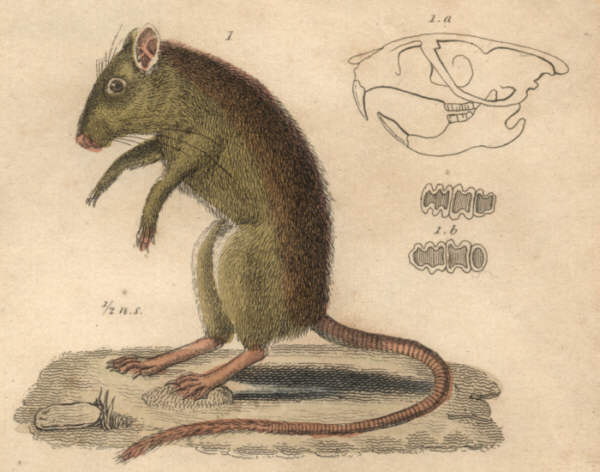
This illustration of The Greater Egyptian Gerbil (Gerbillus
pyramidum), also sometimes called The Pyramid Gerbil, comes from an English
translation of Baron
Cuvier's historic 1817 work "Le Règne animal distribué d'après son
organisation" . This translation was published in London in 1837 as
"The Animal Kingdom arranged according to its organisation". The
picture is only one of three on the page. Click on the above image to see the
whole print, which also includes drawings of a Common European Hamster (Cricetus
cricetus), and a Root Vole (Microtus oeconomus), although
different scientific names were used by Cuvier for these species.
Greater Egyptian Gerbil
By and
This article first appeared in the December 2000 issue of the NGS
Journal.
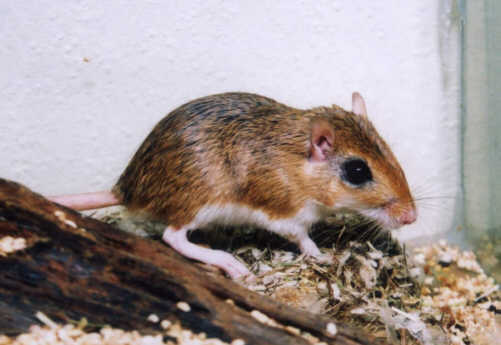
The Greater Egyptian Gerbil (Gerbillus pyramidum), sometimes called The
Pyramid Gerbil, is a medium sized gerbil that lives in many parts of North
Africa. In appearance it is quite distinctive from the other gerbil species I
have seen. Firstly, the head is more sloped, and more pointed than is usual in a
gerbil, and the ears are much smaller than you would expect in a gerbil of this
size. From nose to the tip of the tail they are about 240mm (9.5 inches) long,
with the tail being about the same length as the body. In colour they are darker
than most gerbillus species, being a dull brown agouti colour, although as is
usual with small animals that have such a large range the colour will vary from
place to place depending on the colour of the soil on which the gerbils live.
Their tails almost totally lack fur, and their bellies are white. It appears
that at least in some areas the colour of juveniles is darker than adults.
Greater Egyptian Gerbils live right across the North African Deserts from the
Red Sea to the Atlas Mountains, although there is a break in that they are
absent from even suitable habitats along the Egyptian/Libyan border. They extend
southwards into Chad and Sudan. Notwithstanding the above, the taxonomy of G.
pyramidum is unclear. Animals trapped outside Egypt exhibit a range of
significant differences in both their physical appearance and their chromosomes.
It is therefore possible that what is known as G. pyramidum is really a group of
closely related species.
These gerbils are a very common rodent in the oases of the Sahara, living
mainly on the bordering sandy areas. They are often only resident where they can
access the dates that fall form the palms. Researchers have been known to obtain
specimens for study by paying local Arabs for animals they have caught in their
homes. In some areas these gerbils avoid barren desert but in others they manage
to live amongst the few shrubs that eke out a living in hammada type desert
common in the Sahara. In the Sudan they often burrow into the softer sand which
gathers around bushes and at the base of acacia trees.
They are nocturnal, appearing as soon as the sun sets, although they are
sometimes observed during the day. They do not usually go far from their
burrows, and quickly disappear down a hole when disturbed. During daytime they
plug the entrance of their burrow with sand. This species has been observed sand
bathing in the wild and burrow entrances often have a bowl of soft sand where
bathing has taken place immediately outside. Osborne and Helmy who studied these
gerbils in Egypt found them very nervous, difficult to handle and prone to
biting.
Greater Egyptian Gerbils breed from June to February in the wild, and litter
size varies between two and seven. Gestation lasts 22 days. Born hairless and
blind, the pups start to crawl at eight days. Eyes open on the nineteenth or
twentieth day. Weaning takes until the 25th or 30th day. Once the eyes are open
the pups start to venture out of the burrow. Researchers have captured pups as
young as 19 to 23 days. In captivity they live until just under two years.
About 6 months ago Karin acquired her first pair of Gerbillus pyramidum. At
that time, she had not seen them before. She knew the person who gave them to
her had some, and she told him enthusiastically, that she would be very
interested in seeing them one day. She was not expecting that he would conclude
that she would like to own a pair!
She was a little reserved about purchasing this species, as she was always
told that they where very shy and not very tame. But when offered, she surely
couldn't refuse, she wanted to experience first hand what they were like.
Although several people warned her: "that is not a species for you, you
will be disappointed, they are sooo shy!"
She decided to give it a go, though, and got a very young pair. She placed
them in a big tank, equipped with two clay pots for nesting, a branch under
which they could hide and a sand bowl. She provided two nesting places, as Karin
was told that the female would chase the male away when she was pregnant.
Surprisingly they always only use one pot, though, the female has not been
pregnant, as far as can be seen. Karin hopes that next spring they will breed.
Although they breed Autumn and Winter in North Africa, the European may be more
conducive to breeding in summer. Recently Karin saw them fight, and thought
something was happening, but it was the male chasing the female. At first she
thought it was about the food, but when she put food all around the cage, it was
clear that was not the problem. They argue as Cheesman's do, lots of squeaking
and boxing, not very serious, no injuries. About 15 minutes later it was over,
and she hasn't seen them arguing since.
Karin has not found them very shy! It could be that these two are
particularly cheeky, but they are curious as Mongolians! True, they are somewhat
nervous, but when the cage is opened, they always come towards the entrance.
They have not proved any more difficult to handle than other Gerbillus species,
and they certainly do not bite.
They do not drink much water, tend to hide their food and don't use the sand
bowl, except as a sleeping place, than they fill it with nesting material, or as
food storage. They are very nocturnal, but when disturbed during the day, they
often come out to have a look. They move in a very special way, the way they
walk is more rat-like.
Overall Karin has found these gerbils to be very nice animals to keep, and
beautiful to look at. She is not disappointed in them at all! And she hopes they
will breed next year!
References
NOTES ON MAMMALS FROM THE NILE DELTA REGION OF EGYPT: Setzer W H, 1952,
Proceedings of the Unites States National Museum, 102(3305)
CYTOLOGICAL CONTRIBUTIONS TO THE PHYLOGENY AND CLASSIFICATION OF THE RODENT
GENUS GERBILLUS: Wahrman J and Zahavi A, 1955, Nature, 175, 600-602
MAMMALS OF THE ANGLO-EGYPTIAN SUDAN: Setzer H W, 1956, Proceedings of the
Unites States National Museum, 106 (3377)
RODENTS OF LIBYA: Rank G L, U.S. National Museum Bulletin 275, 1968
THE ECOLOGY OF RODENTS IN THE NORTHERN SUDAN: D C D Happold, Chapter II of
RODENTS IN DESERT ENVIRONMENTS, Prakash, L and Gosh, P.K. (volume editors), Dr
W. Junk b.v. Publishers, The Hague, 1975, 90 6193 080 4
CHROMOSOMES OF SOME SPECIES OF GERBILLUS (MAMMALIA RODENTIA).: Lay, D.M.,
Agerson, K., Nadler, C.F., 1975, Zeitschrift fuer Sauegetierkunde, 40, 141-50
THE CONTEMPORARY LAND ANIMALS OF EGYPT (INCLUDING SINAI). (Fieldiana Zoology,
no. 5), Osborn, D.J. & Helmy, I.,1980
TAXONOMY OF THE GENUS GERBILLUS (RODENTIA: GERBILLINAE) WITH COMMENTS ON THE
APPLICATIONS OF GENERIC AND SUBGENETRIC NAMES AND AN ANNONATED LIST OF SPECIES.:
Lay, D.M., 1983, Zeitschrift fuer Sauegetierkunde, 48, 329-354
THE MAMMALS OF ARABIA (Second Edition), Harrison DL, Bates PJJ, Harrison
Zoological Museum Publication, 1991
MAMMALS OF ALGERIA, Kowalski, K. Rzebik-Kowalska, B, Zaklad Narodowy Imienia
Ossolinskich Wydawnictwo Polskiej Akademii Nauk Wroclaw, Poland, 1991
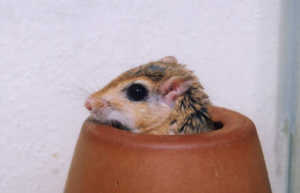
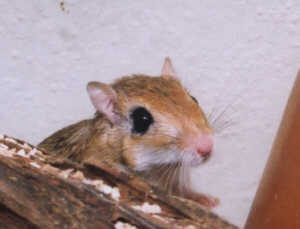
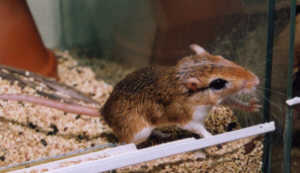




























Return to the NGS Homepage?
The views presented on this page are not necessarily those of the National
Gerbil Society.
Please note that the material on these webpages is covered by copyright law.
If you wish to use any pictures etc for anything other than your personal
private use, such as publishing material on a website, then
This web page may include links to other web sites. These links are provided
in order to enhance the interest and usefulness of other content and are not
intended to signify that the National Gerbil Society, or the authors of material
featured on the NGS Website, endorses or otherwise has any responsibility for
the content of any linked web page, web site or other linked material.
This page has been constructed by
Telephone number for media contact only - (+44)
07941893143
Last updated 22 September 2007





